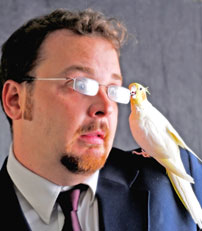
There are over 350 kinds of parrots, one of the most colorful, fascinating and intelligent creatures. Animal Planet named them the “smartest animals in the world” because of their ability to not just mimic words, but understand meanings and carry conversations with their owners. Parrots can also solve puzzles, learn tricks, and even use tools.
Fast facts about the Psittacines clan
Parrots vary in color, size, even capabilities. Did you know that there is a parrot that can’t fly? And that the smallest of its kind, the Buff-faced Pygmy Parrot, is just 3.2 inches tall? Compare that to Hyacinth Macaw, who towers at 3.3 feet!
However, parrots do share some characteristics as members of one psittacines order (that’s what the scientists call them!). This Includes a curved beak, and “zygodactil” toes—meaning, there are two in the front, and two in the back. This lets them perch on a branch while maintaining a completely erect posture.
Cockatoos and Parrots
There is a misconception that cockatoos (cacatuidae) and parrots (psittacidae) are completely different. Actually, they are the two branches of the psittacines order.
What’s the difference? Cockatoos have a movable head crest (what one pet owner humorously described as “that Mohawk thing going on in their heads”). They also have a gall bladder, and are generally larger. The exceptions are the miniature cockatiels and the giant parrots like the Kakapo and the Macaw.
Enthusiasts also say that parrots are prolific talkers, but cockatoos are much better at learning tricks or solving puzzles.
So, the rule of thumb is that all cockatoos are parrots but not all parrots are cockatoos. Other members of the parrot family include Parakeets, African Grays, Conures, Caiques, Amazons, and Quakers.
Origins of Parrots
Parrots proliferated in nearly every continent that had decently warm weather: Most came from South America, North America and Australia, though others originated from Africa and Southeast Asia. Only the Carolina Parakeet (now extinct) and the Thick-billed Parrot were naturally found in the United States.
Intelligence and Speech
Scientists are just beginning to realize how smart parrots really are. They were once dismissed as “hopelessly simple” because of their smaller cerebral cortex, the traditional area of intelligence for animals. (This is probably the reason for the idiom, “bird brained.”)
However, researchers have realized that parrots just use another area of the brain, and that if you look at the hyperstriata and other parts of the lower brain, it’s actually wired in a way that’s surprisingly similar to ours.
That’s why parrots have very developed language abilities, and can perform “creative logic”—identifying a problem, and then experimenting with different tools and solutions.
One very famous African Gray parrot called Alex was trained by animal behaviorists to name objects, count, and even do simple puzzles (how many yellow circles are hidden in this picture?). It wasn’t mere memory work, since Alex actually scored higher on puzzles that depicted unfamiliar objects. Researchers also said that this prolific talker has a vocabulary of 1,000 words, which it would combine in sentences—with accurate tenses! How’s that for a “bird brain”?